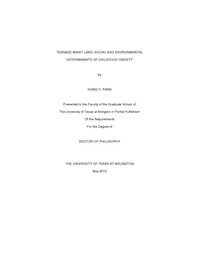| dc.description.abstract | In the past three decades, childhood obesity has emerged as a growing concern for authorities in diverse disciplines. Authorities in law, economics, medicine, nursing, psychiatry, education, and social work have dedicated research and resources in an attempt to arrest or reverse this alarming trend. Guided by existing gaps in contemporary research, this study expanded the knowledge base by examining the social and environmental determinants of childhood obesity for youths aged 13 to 17 year-olds. The social and environmental determinants of this research were guided by the Ecological Systems Theory and Social Capital Theory, and those determinants included academic development, medical access, social capital, and physical environment.Using the 2007 - 2008 National Survey of Children's Health, a total of 30,097 youths aged 13 to 17 years were included in this study. Chi-square and logistic regression were used to test for associations between the demographic variables and their relationships to childhood obesity and to assess whether the independent variables were predictors of childhood obesity, respectively. Lastly, logistic regression was used to determine which of the four independent variables remained statistically significant when they were combined into the final model.Of the different variables, academic development was the best predictor of childhood obesity. Consistent with existent literature, social capital, physical environment, and medical access were all statistically significantly correlated to childhood obesity. In addition, demographic characteristics such as minority status, male gender, and low socioeconomic status increased the risk for being obese. On the other hand, environmental protective factors that lowered the risk included presence of neighborhood playgrounds, walking paths, recreation centers, and community centers. In the final chapter, the significance of these findings is discussed as are the social work implications, limitations, recommended policies, and future research. | en_US |


